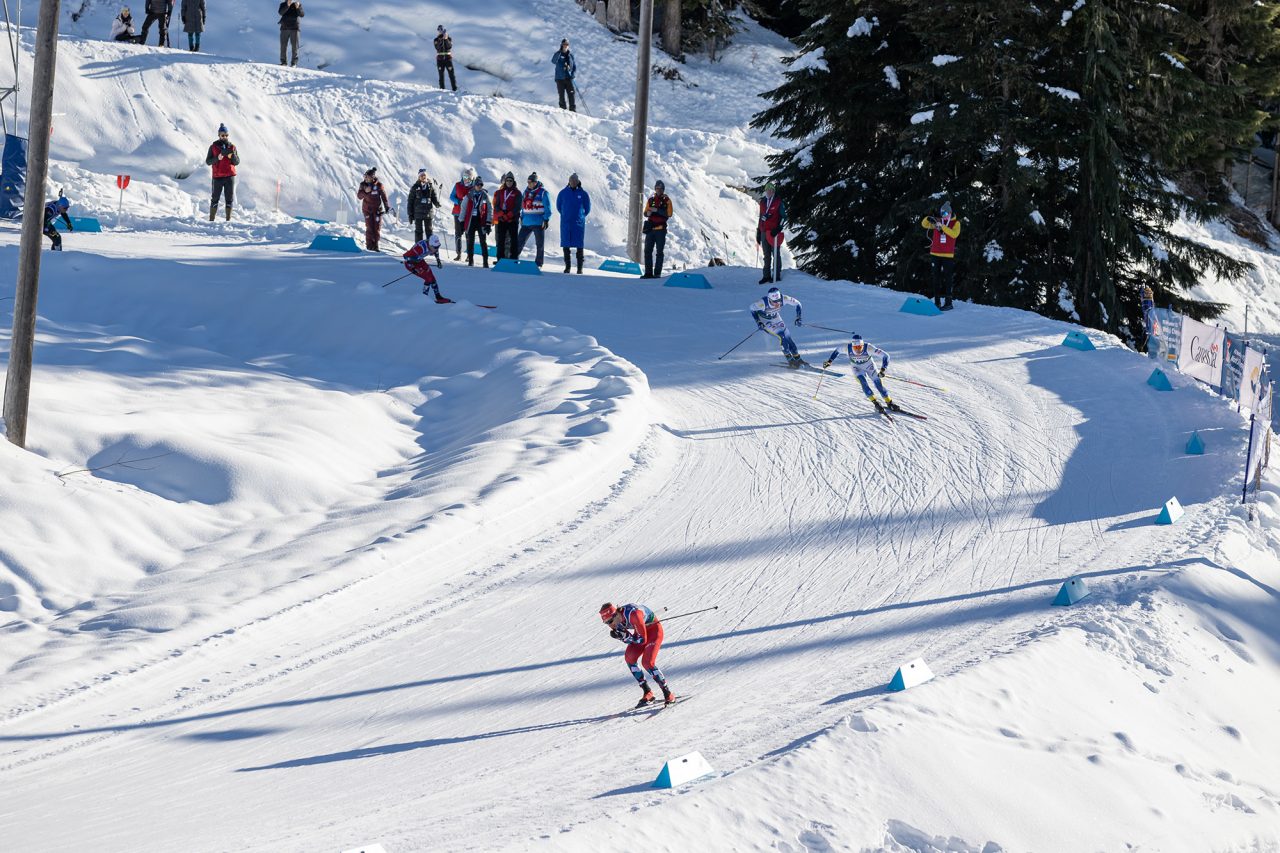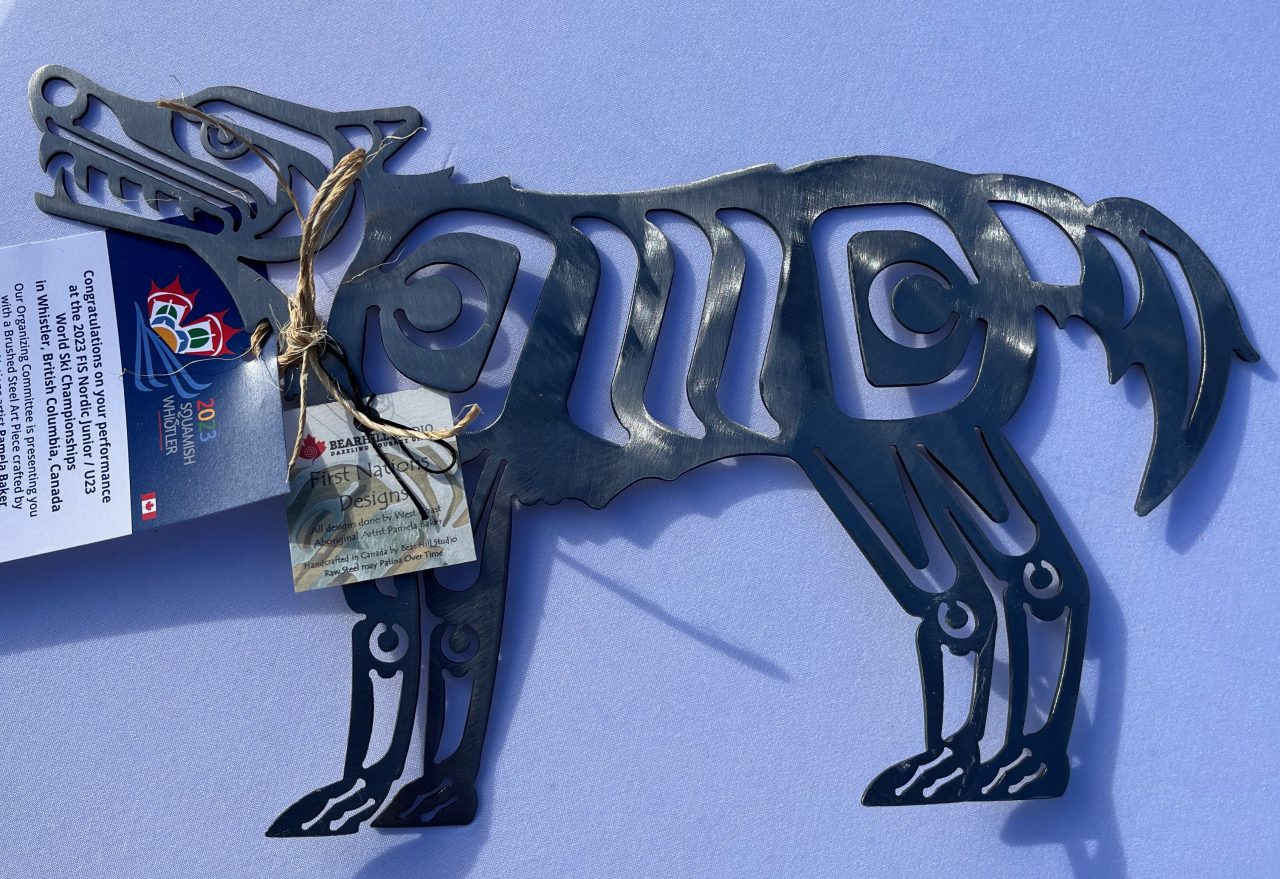
Day two at Whistler Olympic Park was similar to the first: sunny, fast, and exciting.
The excitement started early, with pre-race favourite JC Schoonmaker crashing spectacularly on the sweeping right-hand drop into the stadium during the qualifier. Seeded second, he was quick to be back up and skiing, but 150m of double poling with one pole cost him more time on top of the loss of time and speed from the fall. Schoonmaker would fail to qualify for the heats.
That corner is pretty easy when cruising on a long slow training day, but it has also ended many dreams over the years. FasterSkier asked Schoonmaker to explain what is different at sprint pace.
“You’re just going in with that extra little bit of speed, it makes it a little more tricky, and you have tired legs going into it,” he explained. “And that’s why you have to have your head in the game, and mine wasn’t there today.”
The two downhill corners would generate a lot of excitement in the heats. The left hairpin after the longer opening climb changed during the day. The “defensive” line, starting inside and finishing outside, got scraped smooth in the quarters. The “fast” line, entering very wide and exiting inside with much higher speed held out much better, despite many more skiers using it today after Xav McKeever’s well-executed demonstration of the gains was featured on the livestream video from Saturday.
In the women’s heats, the only two North Americans who qualified exited in the quarterfinals. Sydney Palmer-Leger qualified 30th and wasn’t able to match pace in a stacked first heat that produced both lucky losers. She finished sixth in the heat and 30th overall. Novie McCabe qualified 24th and finished fifth in heat 2 for a 23rd place.
Finland’s Jasmin Kahara was on a mission to upgrade her 13th place in last year’s U23 sprint, winning the qualifier and leading out all three heats on her way to the U23 title. Norway’s Kristin Austgulen Fosnæs moved up in the final 200 m to take second with teammate Sigrid Lesotho Føyen in third.
“Amazing, I have been waiting for this for many years and it was a perfect day,” Kahara told the livestream interviewer Tom Stephen at the finish. “I wanted to be in the front and do my best and ski as fast as possible.”
The simplest way to stay out of trouble is to go to the front and stay there. Kahara was the only skier on the day who could make that strategy work.
“It was amazing, I really didn’t expect to be that good today. The waxers did an amazing job,” Fosnæs said with a smile. “I tried to follow the Finnish girl’s track and try to keep her as close as possible, and then try to hold on to the finish line.”
“I got the bronze medal, and I’m really happy with that,” Føyen told FasterSkier. “I was really afraid they were going to slide me in from the top, but they didn’t.” Føyen entered the stadium in third, drafting Fosnæs, with just enough of a gap on Sweden’s Moa Hansson and Italy’s Nicole Monsorno to prevent a slingshot.
For the men, Norway’s Lars Agnar Hjelmeset won the qualification and his first quarterfinal in style before getting boxed in the semifinal. In the final, it would be fellow Norwegian Ansgar Evensen surprising the field with an attack on the second climb. Sweden’s George Ersson won a photo finish for second, 0.02 ahead of teammate Emil Danielsson, and 0.80 behind Evensen.
“In the heats, I tried to save as much energy as possible on the hill, and go really hard when I got into the stadium,” Evensen said. “I just decided on the [second] hill… but when I got the free track and felt good, I just went for it.”
Evenssen exploded the field, with only the two Swedish skiers staying together but not close enough to draft.
“It was amazing,” Ersson said.” I had amazing skis, body felt good, couldn’t be any better. I’m really satisfied with my second place.”
“I didn’t want to be first before the downhill to the stadium. It worked in the quarterfinals, but in the finals, Ansgar had a gap.”
“Amazing,” Danielssen said afterward. “Nice weather, good shape, good skis, on the podium with my friend, it couldn’t be better.”
There is a theme to the Swedish interviews on the first two days, seemingly channeling the great Marit Bjørgen who collected five medals on these tracks in 2010. “The shape is good, the skis are good.”
The fourth place finisher, Norway’s Jonas Vika, completed the corner drama for the day with a spectacular maneuver after his aggressive line choice backfired.
“There was about this much space outside the v-board,” Vika explained, holding his fingers about 8 cm apart. “I don’t know how I stayed on the skis, but I’m really glad I did.”
Three North Americans made the heats. Gus Schumacher and Luke Jager came in with high expectations. Canada’s Sasha Masson did not.
“It was quite a big surprise that I qualified this morning, knowing there’s so many fast athletes out there,” Masson explained. “The techs did a really good job for the kick and the glide, and I just made it happen this morning.”
After qualifying 26th, Masson found his attempts to move up in the quarterfinal blocked, leaving him happy in 23rd for the day.
“For the heats, it was a good experience. A little more international experience would be fun.”
Schumacher qualified 24th and was happy with his heat.
“It was good, my plan was to make the time as fast as possible,” he said after getting eliminated. “I slotted in behind the fastest bib in our heat, led over the top, kind of lost an edge a little bit in that icy corner.” “I got spit wide, came around the corner here in third, and maybe not close enough to slingshot.”
“I was pretty proud of it, my classic sprinting has never really been my best. It was a good way to start the week and really fun to be in a heat again.”
Jager, like Schoonmaker, was expected to compete and even feature in the final.
“It was kind of a mixed bag. My qualifier, I finished and thought it was pretty good, but the results told a different story,” Jager said, after qualifying 20th and reaching the semifinals as a lucky loser.
“My quarterfinal was really tight, really fast, and thankfully Lars was pinning it from the front the whole time. I had to sit anxiously for four more heats.”
“I was hoping to try the same thing in the semi, just stay back and avoid trouble, but I managed to find trouble anyway.”
On the first short steep turn up out of the stadium, the tight packed group got out of the tracks and Jager found himself with a broken pole at the start of the diagonal stride technique zone.
“That’s a good reminder, not matter how hot you think you are, stuff happens.”
Jager, like Schoonmaker, was philosophical and still upbeat. “Anyone can do it, once you’re in the heats, but definitely some people can do it with less energy than others.”
The last word goes to Ersson.
“If you were to wish for one condition to compete in, this would be it. Sunny, hard tracks, it couldn’t be any better.”
Full results for the week are on the FIS website, including video replays of the first two days and live video for the remaining events.




